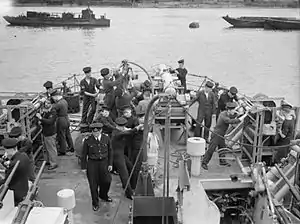HMS Hind (U39)
HMS Hind was a modified Black Swan-class sloop of the Royal Navy. She was laid down by William Denny and Brothers, Dumbarton on 31 August 1942, launched on 30 September 1943 and commissioned on 11 April 1944, with the pennant number U39.[1]
 HMS Hind anchored in 1943. | |
| History | |
|---|---|
| Name: | Hind |
| Namesake: | Hind |
| Ordered: | 11 February 1942 |
| Builder: | William Denny and Brothers, Dumbarton |
| Laid down: | 31 August 1942 |
| Launched: | 30 September 1943 |
| Commissioned: | 11 April 1944 |
| Decommissioned: | 1951 |
| Identification: | Pennant number: U39 |
| Fate: | Broken up in 1959 |
| General characteristics | |
| Class and type: | Modified Black Swan-class sloop |
| Displacement: | 1,350 tons |
| Length: | 283 ft (86 m) |
| Beam: | 38.5 ft (11.7 m) |
| Propulsion: |
|
| Speed: | 20 knots (37 km/h) at 4,300 hp (3,200 kW) |
| Complement: | 192 men + 1 Cat |
| Armament: |
|
Construction and career
HMS Hind joined Western Approaches Command in April 1944, and after taking control at Tobermory, she was designated to support the Allied landings in Normandy.

In May 1944, she participated in the preliminary exercises of Operation Neptune with the ships of the Force G and was assigned to deployment with escort group 112 during the landings of June 1944. Released from Operation Neptune, she was retained in the English Channel for escort duties at Plymouth Command, then joined the Eastern Fleet (Far East Fleet) and deployed to defend convoys in the Indian Ocean and the Persian Gulf from November 1944 until the end of the war.
HMS Hind joined the British Pacific Fleet in Hong Kong in September 1945 and was deployed on patrols and in support of repatriation operations.
Hind was transferred to the 32nd Escort Flotilla at the end of the year and left for repairs and improvements in Brisbane in February 1946. This ship rejoined her flotilla at the end of the work, then later joined the 1st escort flotilla. When the Far Eastern Fleet replaced the British Pacific Fleet in 1949, this flotilla was renamed the 3rd Frigate Flotilla. The ship remained in the Far East until 1951, when she left the Station to return to the United Kingdom.
Upon arrival, she was released from active service and reduced to reserve status at Portsmouth. In 1951, she was assigned to the Reserve Fleet Subdivision at Hartlepool. Listed for demolition in 1957, she was sold to BISCO for dismantling by Clayton and Davie in Dunston, Tyne and arrived at the demolition site on 10 December 1959.[2]
See also
References
- "HMS Hind (U 39) of the Royal Navy - British Sloop of the Modified Black Swan class - Allied Warships of WWII - uboat.net". uboat.net. Retrieved 20 October 2020.
- "HMS Hind, sloop". www.naval-history.net. Retrieved 20 October 2020.
Further readings
- Blackman, Raymond V. B. (1971). Jane's Fighting Ships 1971–72. London: Sampson Low, Marston & Company. ISBN 0-354-00096-9.
- Blair, Clay Gardiner (2000). Hitler's U-Boat War: The Hunted 1942–1945. Vol. 3. New York: Modern Library. ISBN 0-679-64033-9.
- Gardiner, Robert Gardiner (1980). Conway's All the World's Fighting Ships (1922-1946). Vol. 3. Conway Maritime Press. p. 456. ISBN 0-85177-146-7.
- Gardiner, Robert Gardiner (1996). Conway's All the World's Fighting Ships (1947-1995). Vol. 4. US Naval Institute Press. p. 675. ISBN 1-55750-132-7.
- Colledge, J. J.; Warlow, Ben (2006) [1969]. Ships of the Royal Navy: The Complete Record of all Fighting Ships of the Royal Navy (Rev. ed.). London: Chatham Publishing. ISBN 978-1-86176-281-8.
- Hague, Arnold (1993). Sloops: A History of the 71 Sloops Built in Britain and Australia for the British, Australian and Indian Navies 1926–1946. Kendal, England: World Ship Society. ISBN 0-905617-67-3.
